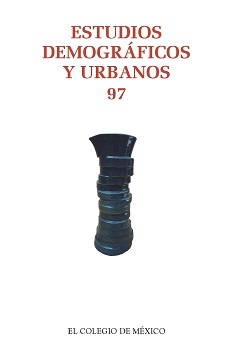Notes and commentaries
Published 2018-01-01
Keywords
- demographic transition,
- ageing population,
- demographic dividend,
- Argentina
How to Cite
Geri, M., Lago, F., & Moscoso, N. (2018). Demographic dividends in Argentina, 1960-2015. Estudios Demográficos Y Urbanos, 33(1), 225–252. https://doi.org/10.24201/edu.v33i1.1724
Metrics
Views/Downloads
-
Abstract2565
-
PDF (español)591
-
En línea (español)1517
Downloads
Download data is not yet available.
Copyright (c) 2018 Estudios Demográficos y Urbanos

This work is licensed under a Creative Commons Attribution-NonCommercial-NoDerivatives 4.0 International License.
Metrics
Abstract
Ageing population is produced as a consequence of demographic transition, out of which children population is reduced and elderly population increases. Negative economic consequences of this change can be mitigated taking advantage of the first and second demographic dividends. The first one consists in a transitory increase of the job supply, while the second one bases on the increase of productivity caused by a bigger human capital per capita. This paper investigates Argentinean capability to take advantage of the opportunities presented by these dividends by comparing census data of 1960 and 2010. We conclude that female population has shown more participation in labor force and better education levels, while the male population has shown less participation in labor force and practically the same distribution of scholar assistance by education levels.References
- Ashraf, Quamrul, David Weil y Joshua Wilde (2013), “The effect of fertility reduction on economic growth”, Population and Development Review, vol. 39, núm. 1, pp. 97-130. Recuperado de http://onlinelibrary.wiley.com/doi/10.1111/j.1728-4457.2013.00575.x/epdf DOI: https://doi.org/10.1111/j.1728-4457.2013.00575.x
- Becker, Gary y Robert Barro (1988), “A reformulation of the economic theory of fertility”, The Quarterly Journal of Economics, vol. 103, núm. 1, pp. 1-25. Recuperado de https://www.jstor.org/stable/1882640?seq=1#page_scan_tab_contents DOI: https://doi.org/10.2307/1882640
- Bloom, David, David Canning, Günther Fink y Jocelyn Finlay (2009), “Fertility, female labor force participation, and the demographic dividend”, Journal of Economic Growth, vol. 14, núm. 2, pp. 79-101. Recuperado de https://www.jstor.org/stable/27750779?seq=1#page_scan_tab_contents DOI: https://doi.org/10.1007/s10887-009-9039-9
- Bloom, David, David Canning y Jaypee Sevilla (2003), The demographic dividend: A new perspective on the economic consequences of population change, Santa Monica, CA, Population Matters. DOI: https://doi.org/10.7249/MR1274
- Censo Nacional de Población, Hogares y Viviendas (1960), Repositorio no oficial de datos públicos abiertos de la República Argentina. Recuperado de http://datar.noip.me/dataset/censo-nacional-1960
- Censo Nacional de Población, Hogares y Viviendas (2010), Página oficial del Instituto Nacional de Estadísticas y Censos (INDEC) de la República Argentina, Buenos Aires. Recuperado de www.indec.gov.ar
- Chesnais, Jean-Claude (1979), “L’effet multiplicatif de la transition démographique”, Population, vol. 34, núm. 6, pp. 1138-1144. Recuperado de http://www.jstor.org/stable/1531438?seq=1#page_scan_tab_contents DOI: https://doi.org/10.2307/1531438
- Chesnais, Jean-Claude (1985), “Progrès économique et transition démographique dans les pays pauvres: trente ans d’expérience (1950-1980)”, Population, vol. 40, núm. 1, pp. 11-28. Recuperado de http://www.persee.fr/docAsPDF/pop_0032-4663_1985_num_40_1_17493.pdf DOI: https://doi.org/10.2307/1532954
- Chesnais, Jean-Claude (1986), “La transition démographique: Étapes, formes, implications économiques. Etude des séries temporelles (1720-1984) relatives à 67 pays”, Population, vol. 41, núm. 6, pp. 1059-1070. Recuperado de http://www.persee.fr/docAsPDF/pop_0032-4663_1986_num_41_6_17679.pdf DOI: https://doi.org/10.2307/1532931
- Kuznets, Simon (1967), “Population and economic growth”, Proceedings of the American Philosophical Society, vol. 111, núm. 3, pp. 170-193. Recuperado de http://www.jstor.org/stable/985714?seq=1#page_scan_tab_contents
- Lee, Ronald (2003), “The demographic transition: Three centuries of fundamental change”, Journal of Economic Perspectives, vol. 17, núm. 4, pp. 167-190. Recuperado de http://pubs.aeaweb.org/doi/pdfplus/10.1257/089533003772034943 DOI: https://doi.org/10.1257/089533003772034943
- Lee, Ronald y Andrew Mason (2010), “Fertility, human capital and economic growth over the demographic transition”, European Journal of Population, vol. 26, pp. 159-182. Recuperado de https://link.springer.com/content/pdf/10.1007%2Fs10680-009-9186-x.pdf DOI: https://doi.org/10.1007/s10680-009-9186-x
- Malthus, Thomas (1798), An essay on the principle of population, Londres, St. Paul’s Church-Yard.
- Mason, Andrew y Ronald Lee (2007), “Transfers, capital, and consumption over the demographic transition”, en Robert Clark, Naohiro Ogawa y Andrew Mason (eds.), Population aging, intergenerational transfers and the macroeconomy, Cheltenham Edward Elgar Publishing. DOI: https://doi.org/10.4337/9781847208583.00014
- Mason, Andrew, Ronald Lee y Jennifer Jiang (2016), “Demographic dividends, human capital and saving”, The Journal of the Economics of Ageing, vol. 7, pp. 106-122. Recuperado de http://www.sciencedirect.com/science/article/pii/S2212828X16000050
- Ordorica, Manuel (2007), “La población mexicana de 2011: lo que no ocurrió”, Estudios Demográficos y Urbanos, vol. 22, núm. 1 (64), pp. 213-218. Recuperado de http://estudiosdemograficosyurbanos.colmex.mx/index.php/edu/article/view/1298/1291 DOI: https://doi.org/10.24201/edu.v22i1.1298
- Pinto Aguirre, Guido (2016), “El bono demográfico en América Latina: el efecto económico de los cambios en la estructura por edad de una población”, Población y Salud en Mesoamérica, vol. 13, núm. 2, pp. 1-17. Recuperado de http://revistas.ucr.ac.cr/index.php/psm/article/view/21863/22877 DOI: https://doi.org/10.15517/psm.v13i2.21863
- Solow, Robert (1956), “A contribution to the theory of economic growth”, Quaterly Journal of Economics, vol. 70, núm. 1, pp. 65-94. Recuperado de http://piketty.pse.ens.fr/files/Solow1956.pdf DOI: https://doi.org/10.2307/1884513
- United Nations (2005), “United Nations Expert Group Meeting on Social and Economic Implications of Changing Population Age Structures”, reunión de trabajo, Department of Economic and Social Affairs, Population Division, Ciudad de México, 31 de agosto a 2 de septiembre. Recuperado de http://www.un.org/esa/population/meetings/EGMPopAge/EGMPopAge.htm
- Vega Romero, Román (2009), “Informe de la Comisión Determinantes Sociales de la Salud de la Organización Mundial de la Salud”, Revista Gerencia y Políticas de Salud vol. 8, núm. 16 pp. 7-11. Recuperado de http://www.scielo.org.co/scielo.php?script=sci_arttext&pid=S1657-70272009000100001&lng=en&nrm=iso. ISSN 1657-7027


